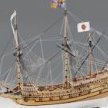
VinceMcCullough
-
Posts
43 -
Joined
-
Last visited
Reputation Activity
-
 VinceMcCullough got a reaction from Canute in Is there a Beginner’s Guide to Metal Work?
VinceMcCullough got a reaction from Canute in Is there a Beginner’s Guide to Metal Work?
I highly recommend the Foran and Underhill books. Foran is a good introduction to working in brass to build entire brass models, which are mostly aircraft. He is fantastically creative. He does not, if I recall, use silver soldering in his book, instead relying on soft solders.
Underhill is specifically focused on ship modeling, and has useful tips on how to fabricate the small but complicated parts that we need. He speaks about silver soldering, using an alcohol lamp and a blowpipe. Today you can use butane torches and silver solder paste, which are a lot easier.
-
 VinceMcCullough got a reaction from AgesOfSail in Question about paddle box and sponson of Paddle steamer ferry
VinceMcCullough got a reaction from AgesOfSail in Question about paddle box and sponson of Paddle steamer ferry
This gets a little difficult to describe, but here goes ...
The weight of the paddle box itself is carried by three beans: two “paddle beams” that run athwartship, and a “spring beam” that connects the outer ends of the paddle beams. The paddle beams sit under the forward and aft ends of the paddle box and the spring beam sits under the outer “face” of the box.
The paddle decks, sometimes called wing decks, are forward and aft of the box, and are usually triangular in shape. Like the paddle box, the paddle decks are supported by a series of atwartship beams. A fender beam mounted on the end of these beams forms the outer edge of the paddle decks. The fender beams join into the spring beam by scarf joints, producing a smooth transition from the fender to the spring beam.
The paddle decks were often perforated using either gratings or perforated steel plate. This allowed water to drain from the decks and, more importantly, to go UP through the perforations when the ship was struck by a wave or heeled enough to submerge the paddle deck.
The stays aided in supporting the decks against the impact of the water. Without them the paddle decks could be torn off by the force of water trapped under the falling paddle decks.
BTW, I learned most of this while researching and developing plans for a civil war blockade robber. The plans will be included with a book that will be published in the near future.
-
 VinceMcCullough got a reaction from Mirabell61 in Question about paddle box and sponson of Paddle steamer ferry
VinceMcCullough got a reaction from Mirabell61 in Question about paddle box and sponson of Paddle steamer ferry
Ilhan
The deck beams could be either angles or I-beams, but I would bet on I -beams. The blockade runner I’m working on used I-beams constructed of steel plate sandwiched between a pair of angles on the top and bottom.
Your plans look great, and it looks like a sweet little steamer. Are you using a CAD program or drawing by hand?
Vince
-
 VinceMcCullough reacted to Ilhan Gokcay in Question about paddle box and sponson of Paddle steamer ferry
VinceMcCullough reacted to Ilhan Gokcay in Question about paddle box and sponson of Paddle steamer ferry
Hey Vince thanks for the info.
I believed that the stays (I call them "support") are to support the beams (I call them "sponson") and the paddle box. Interesting.
So there are beams with no stays where I marked red as the one shown on the cross section plan.
Then next to these beams there are stays very close to them. Do these stays end simply at the outer edge or are there again beams to hold these stays and also support the paddle box deck.
-
 VinceMcCullough got a reaction from trippwj in Question about paddle box and sponson of Paddle steamer ferry
VinceMcCullough got a reaction from trippwj in Question about paddle box and sponson of Paddle steamer ferry
Ilhan
The deck beams could be either angles or I-beams, but I would bet on I -beams. The blockade runner I’m working on used I-beams constructed of steel plate sandwiched between a pair of angles on the top and bottom.
Your plans look great, and it looks like a sweet little steamer. Are you using a CAD program or drawing by hand?
Vince
-
 VinceMcCullough got a reaction from mtaylor in Question about paddle box and sponson of Paddle steamer ferry
VinceMcCullough got a reaction from mtaylor in Question about paddle box and sponson of Paddle steamer ferry
Ilhan
Ive also been using a CAD program, Cadopia, to draw the plans for the blockade runner. I’ve never used Delftship. I’ll have to give it a try.
I took a look at your your Flikr albums. That’s quite a body of work! I was also impressed with your work area. It’s much neater than mine!
Vince
-
 VinceMcCullough got a reaction from druxey in Question about paddle box and sponson of Paddle steamer ferry
VinceMcCullough got a reaction from druxey in Question about paddle box and sponson of Paddle steamer ferry
Ilhan
The deck beams could be either angles or I-beams, but I would bet on I -beams. The blockade runner I’m working on used I-beams constructed of steel plate sandwiched between a pair of angles on the top and bottom.
Your plans look great, and it looks like a sweet little steamer. Are you using a CAD program or drawing by hand?
Vince
-
 VinceMcCullough got a reaction from Ilhan Gokcay in Question about paddle box and sponson of Paddle steamer ferry
VinceMcCullough got a reaction from Ilhan Gokcay in Question about paddle box and sponson of Paddle steamer ferry
Ilhan
Ive also been using a CAD program, Cadopia, to draw the plans for the blockade runner. I’ve never used Delftship. I’ll have to give it a try.
I took a look at your your Flikr albums. That’s quite a body of work! I was also impressed with your work area. It’s much neater than mine!
Vince
-
 VinceMcCullough got a reaction from trippwj in Question about paddle box and sponson of Paddle steamer ferry
VinceMcCullough got a reaction from trippwj in Question about paddle box and sponson of Paddle steamer ferry
This gets a little difficult to describe, but here goes ...
The weight of the paddle box itself is carried by three beans: two “paddle beams” that run athwartship, and a “spring beam” that connects the outer ends of the paddle beams. The paddle beams sit under the forward and aft ends of the paddle box and the spring beam sits under the outer “face” of the box.
The paddle decks, sometimes called wing decks, are forward and aft of the box, and are usually triangular in shape. Like the paddle box, the paddle decks are supported by a series of atwartship beams. A fender beam mounted on the end of these beams forms the outer edge of the paddle decks. The fender beams join into the spring beam by scarf joints, producing a smooth transition from the fender to the spring beam.
The paddle decks were often perforated using either gratings or perforated steel plate. This allowed water to drain from the decks and, more importantly, to go UP through the perforations when the ship was struck by a wave or heeled enough to submerge the paddle deck.
The stays aided in supporting the decks against the impact of the water. Without them the paddle decks could be torn off by the force of water trapped under the falling paddle decks.
BTW, I learned most of this while researching and developing plans for a civil war blockade robber. The plans will be included with a book that will be published in the near future.
-
 VinceMcCullough got a reaction from Ilhan Gokcay in Question about paddle box and sponson of Paddle steamer ferry
VinceMcCullough got a reaction from Ilhan Gokcay in Question about paddle box and sponson of Paddle steamer ferry
This gets a little difficult to describe, but here goes ...
The weight of the paddle box itself is carried by three beans: two “paddle beams” that run athwartship, and a “spring beam” that connects the outer ends of the paddle beams. The paddle beams sit under the forward and aft ends of the paddle box and the spring beam sits under the outer “face” of the box.
The paddle decks, sometimes called wing decks, are forward and aft of the box, and are usually triangular in shape. Like the paddle box, the paddle decks are supported by a series of atwartship beams. A fender beam mounted on the end of these beams forms the outer edge of the paddle decks. The fender beams join into the spring beam by scarf joints, producing a smooth transition from the fender to the spring beam.
The paddle decks were often perforated using either gratings or perforated steel plate. This allowed water to drain from the decks and, more importantly, to go UP through the perforations when the ship was struck by a wave or heeled enough to submerge the paddle deck.
The stays aided in supporting the decks against the impact of the water. Without them the paddle decks could be torn off by the force of water trapped under the falling paddle decks.
BTW, I learned most of this while researching and developing plans for a civil war blockade robber. The plans will be included with a book that will be published in the near future.
-
 VinceMcCullough got a reaction from druxey in Question about paddle box and sponson of Paddle steamer ferry
VinceMcCullough got a reaction from druxey in Question about paddle box and sponson of Paddle steamer ferry
Side wheelers often had iron stays that ran from the outer ends of the paddle beams to the ship’s hull, where they bolted to one of the ship’s frames. These are not supports to keep the paddle decks from sagging. The paddle beams are strong enough to support the decks. The stays are intended to distribute the stress of water impacting the underside of the paddle deck from waves or from the sea surface as the ship heels.
No stays are needed under the forward and aft ends of the paddle boxes because water can flow into the paddle box rather than slamming into the underside of a deck. So there wouldn’t be stays at the locations that you’ve marked in green.
Vince McCullough
-
 VinceMcCullough got a reaction from Ilhan Gokcay in Question about paddle box and sponson of Paddle steamer ferry
VinceMcCullough got a reaction from Ilhan Gokcay in Question about paddle box and sponson of Paddle steamer ferry
Side wheelers often had iron stays that ran from the outer ends of the paddle beams to the ship’s hull, where they bolted to one of the ship’s frames. These are not supports to keep the paddle decks from sagging. The paddle beams are strong enough to support the decks. The stays are intended to distribute the stress of water impacting the underside of the paddle deck from waves or from the sea surface as the ship heels.
No stays are needed under the forward and aft ends of the paddle boxes because water can flow into the paddle box rather than slamming into the underside of a deck. So there wouldn’t be stays at the locations that you’ve marked in green.
Vince McCullough
-
 VinceMcCullough got a reaction from Mirabell61 in Question about paddle box and sponson of Paddle steamer ferry
VinceMcCullough got a reaction from Mirabell61 in Question about paddle box and sponson of Paddle steamer ferry
Side wheelers often had iron stays that ran from the outer ends of the paddle beams to the ship’s hull, where they bolted to one of the ship’s frames. These are not supports to keep the paddle decks from sagging. The paddle beams are strong enough to support the decks. The stays are intended to distribute the stress of water impacting the underside of the paddle deck from waves or from the sea surface as the ship heels.
No stays are needed under the forward and aft ends of the paddle boxes because water can flow into the paddle box rather than slamming into the underside of a deck. So there wouldn’t be stays at the locations that you’ve marked in green.
Vince McCullough
-
 VinceMcCullough got a reaction from mtaylor in Finding sheaves for small functional blocks?
VinceMcCullough got a reaction from mtaylor in Finding sheaves for small functional blocks?
Clamp a piece of sheet stock on your drill press table (the Dremel press should work for this) and drill a hole part way through it with a diameter equal to the outside diameter of your sheave. Without unclamping the sheet, change bits to one the diameter of the shaft through the sheave. Put the sheave in the hole in the sheet and drill the hole for the shaft. It should be exactly centered in the sheave. Then pop the sheave out of the jig ( you might want to use a shaft through the center hole to wiggle it out) and move on to the next sheave.
Vince
-
 VinceMcCullough got a reaction from BETAQDAVE in Best type of micro drill bits for metal
VinceMcCullough got a reaction from BETAQDAVE in Best type of micro drill bits for metal
One other comment on drilling. One of the easiest ways to break a drill is to have it deflect, or “skate” then it makes contact with the workpiece. To avoid this you can to punch a pilot hole at the location where you want to drill. The found two wars of doing this. The first is to make a small punch by grinding a point onto an old drill bit. You can chuck the blunt end of the bit into your drill press and then, while it’s rotating, us a grinding wheel in a rotary tool to grind a point on the end of the bit. The punch can (and should) be quite a bit larger than the hole you want to drill. You just want to make a small dimple for the drill bit to rid in. I put the punch in the press, lower tit down until it presses on the workpiece, then replace the punch with the drill bit for the hole I wNt to drill, angry to work.
the other approach is to use a center drill, which has a large, rigid Drill body with a small spotting drill at the end. These come in various sizes. The smallest that I have is a 5/0 drill, which has an 0.010 diameter spotting drill. These are particularly useful when drilling through a rod. The heavy body of the center drill prevents the spotting tip from skating on the rounded surface of the rod.
Vince
-
 VinceMcCullough got a reaction from thibaultron in Best type of micro drill bits for metal
VinceMcCullough got a reaction from thibaultron in Best type of micro drill bits for metal
One other comment on drilling. One of the easiest ways to break a drill is to have it deflect, or “skate” then it makes contact with the workpiece. To avoid this you can to punch a pilot hole at the location where you want to drill. The found two wars of doing this. The first is to make a small punch by grinding a point onto an old drill bit. You can chuck the blunt end of the bit into your drill press and then, while it’s rotating, us a grinding wheel in a rotary tool to grind a point on the end of the bit. The punch can (and should) be quite a bit larger than the hole you want to drill. You just want to make a small dimple for the drill bit to rid in. I put the punch in the press, lower tit down until it presses on the workpiece, then replace the punch with the drill bit for the hole I wNt to drill, angry to work.
the other approach is to use a center drill, which has a large, rigid Drill body with a small spotting drill at the end. These come in various sizes. The smallest that I have is a 5/0 drill, which has an 0.010 diameter spotting drill. These are particularly useful when drilling through a rod. The heavy body of the center drill prevents the spotting tip from skating on the rounded surface of the rod.
Vince
-
 VinceMcCullough got a reaction from John Allen in Best type of micro drill bits for metal
VinceMcCullough got a reaction from John Allen in Best type of micro drill bits for metal
One other comment on drilling. One of the easiest ways to break a drill is to have it deflect, or “skate” then it makes contact with the workpiece. To avoid this you can to punch a pilot hole at the location where you want to drill. The found two wars of doing this. The first is to make a small punch by grinding a point onto an old drill bit. You can chuck the blunt end of the bit into your drill press and then, while it’s rotating, us a grinding wheel in a rotary tool to grind a point on the end of the bit. The punch can (and should) be quite a bit larger than the hole you want to drill. You just want to make a small dimple for the drill bit to rid in. I put the punch in the press, lower tit down until it presses on the workpiece, then replace the punch with the drill bit for the hole I wNt to drill, angry to work.
the other approach is to use a center drill, which has a large, rigid Drill body with a small spotting drill at the end. These come in various sizes. The smallest that I have is a 5/0 drill, which has an 0.010 diameter spotting drill. These are particularly useful when drilling through a rod. The heavy body of the center drill prevents the spotting tip from skating on the rounded surface of the rod.
Vince
-
 VinceMcCullough got a reaction from Canute in Best type of micro drill bits for metal
VinceMcCullough got a reaction from Canute in Best type of micro drill bits for metal
One other comment on drilling. One of the easiest ways to break a drill is to have it deflect, or “skate” then it makes contact with the workpiece. To avoid this you can to punch a pilot hole at the location where you want to drill. The found two wars of doing this. The first is to make a small punch by grinding a point onto an old drill bit. You can chuck the blunt end of the bit into your drill press and then, while it’s rotating, us a grinding wheel in a rotary tool to grind a point on the end of the bit. The punch can (and should) be quite a bit larger than the hole you want to drill. You just want to make a small dimple for the drill bit to rid in. I put the punch in the press, lower tit down until it presses on the workpiece, then replace the punch with the drill bit for the hole I wNt to drill, angry to work.
the other approach is to use a center drill, which has a large, rigid Drill body with a small spotting drill at the end. These come in various sizes. The smallest that I have is a 5/0 drill, which has an 0.010 diameter spotting drill. These are particularly useful when drilling through a rod. The heavy body of the center drill prevents the spotting tip from skating on the rounded surface of the rod.
Vince
-
 VinceMcCullough got a reaction from pontiachedmark in Best type of micro drill bits for metal
VinceMcCullough got a reaction from pontiachedmark in Best type of micro drill bits for metal
One other comment on drilling. One of the easiest ways to break a drill is to have it deflect, or “skate” then it makes contact with the workpiece. To avoid this you can to punch a pilot hole at the location where you want to drill. The found two wars of doing this. The first is to make a small punch by grinding a point onto an old drill bit. You can chuck the blunt end of the bit into your drill press and then, while it’s rotating, us a grinding wheel in a rotary tool to grind a point on the end of the bit. The punch can (and should) be quite a bit larger than the hole you want to drill. You just want to make a small dimple for the drill bit to rid in. I put the punch in the press, lower tit down until it presses on the workpiece, then replace the punch with the drill bit for the hole I wNt to drill, angry to work.
the other approach is to use a center drill, which has a large, rigid Drill body with a small spotting drill at the end. These come in various sizes. The smallest that I have is a 5/0 drill, which has an 0.010 diameter spotting drill. These are particularly useful when drilling through a rod. The heavy body of the center drill prevents the spotting tip from skating on the rounded surface of the rod.
Vince
-
 VinceMcCullough got a reaction from Keith Black in Miniature Russian carving tools
VinceMcCullough got a reaction from Keith Black in Miniature Russian carving tools
I'd like to have his contact info as well.
vince
-
 VinceMcCullough reacted to Bob Portsmouth in HMS Victory re-paint
VinceMcCullough reacted to Bob Portsmouth in HMS Victory re-paint
I don't know if anyone is still following this but it's been a pet subject in all forums. First, I can't see a trace of pink, it's a dull pale not too pleasant lemon(ish). Peter advises there have been details overlooked, ignored or simply not found since he left and he is of the opinion that they still haven't got it nailed down. Possibly, although the pigments can be identified this doesn't, as already pointed out, allow for impurities. Also I'm not convinced the proportions of the mixture have been accurately determined. If Nelson picked it's present colour he must have had a stinking hangover at the time. Peter has shown me a build which he says is accurate. If so there was more yellow. (colour described by the carpenter as yellow, not yellow ochre, mixed with white)
-
 VinceMcCullough got a reaction from allanyed in when sails not used
VinceMcCullough got a reaction from allanyed in when sails not used
A couple of months ago I did some repairs to som damaged rigging on one of the Rogers Collection models at the US Naval Academy museum, the brig PILOT. The model has no sails and the running rigging was as Dave indicated. Knots were tied in the bitter ends and the they were drawn up to their respective blocks.
Vince
-
 VinceMcCullough got a reaction from mtaylor in Cutting Planks
VinceMcCullough got a reaction from mtaylor in Cutting Planks
Another approach would be to use a shooting board and a small plane. The plane should shave VERY small amounts off the end of the plank, and if it’s sharp, it should give you a very clean end.
-
 VinceMcCullough got a reaction from Bill Tuttle in Sherline model 4400DRO Lathe
VinceMcCullough got a reaction from Bill Tuttle in Sherline model 4400DRO Lathe
I have a Sherline lathe that I subsequently equipped with their DRO as an add-on. It's a huge improvement on counting the number of times that I've cranked the handwheels. I end up with fewer parts spoiled when I lose track of the number of times I've turned the crank.
With regard to portability, the wires unhook readily, so that's not a problem.
-
 VinceMcCullough got a reaction from Canute in My First Attempt At Metal Blackening
VinceMcCullough got a reaction from Canute in My First Attempt At Metal Blackening
I suspect that the problem with the BB’s is due to their composition. BB’s are usually made of steel, not Brass. They have a coating thick is probably brass, but if it has been compromised on some of them, the underlying steel may interfere with the blackening process.














